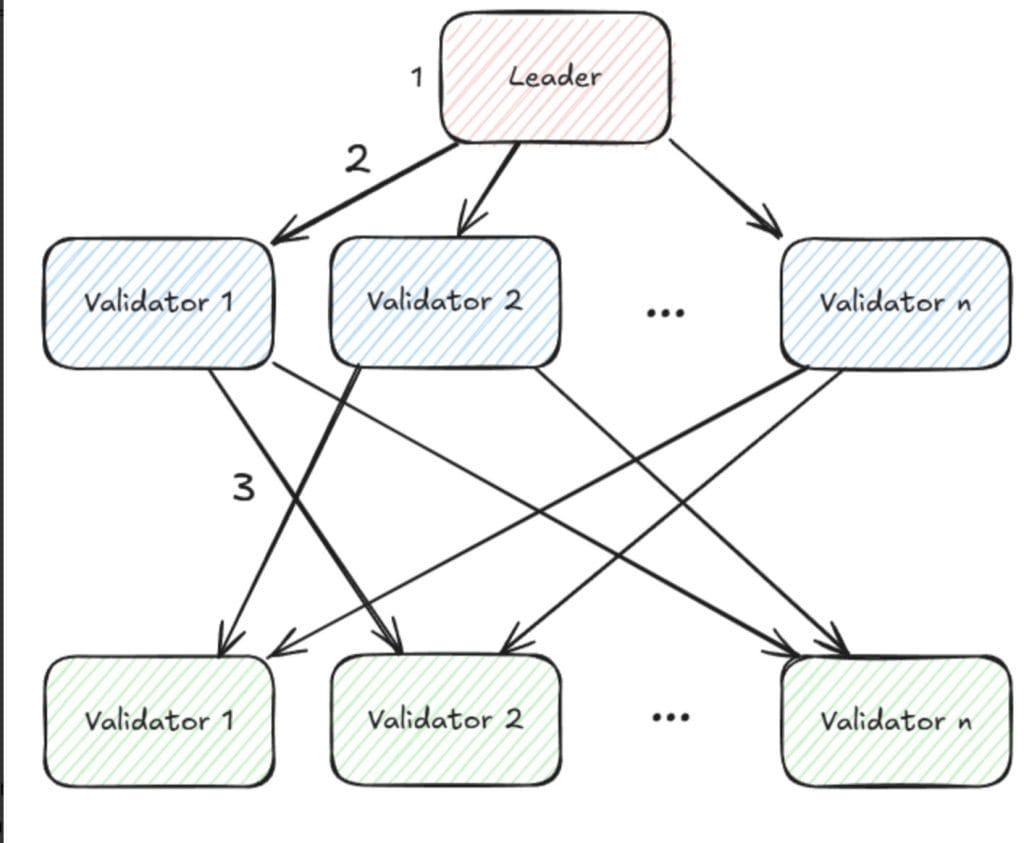Understanding Monad: How It Works
In 2024, Monad made headlines by raising $224 million — marking the largest fundraising round since the 2021 bull market. With this significant capital, Monad has set its sights on becoming one of the fastest and most efficient Layer-1 blockchains in the world.
Boasting a peak throughput of 10,000 transactions per second (TPS) — compared to the 2,000–6,000 TPS range typical of competitors like Sui, Aptos, and Solana — Monad introduces a suite of technical innovations designed to push blockchain performance to new heights. These include:
MonadBFT
RaptorCast
Asynchronous Execution
Parallel Execution
MonadDB
Yet, advanced technology often comes with complexity. This article breaks down each of Monad’s core components through approachable analogies, making them easier to understand.
RaptorCast: The Speed Courier of Data
RaptorCast is Monad’s data propagation protocol, responsible for distributing information from the leader validator to others across the network.
When a transaction arrives, the leader applies Erasure Coding, splitting data into multiple fragments. These fragments are then distributed through an intermediary relay that forwards them to the remaining validators.
In traditional systems like Ethereum, validators share data sequentially — much like gossip spreading from one neighborhood to another. In contrast, RaptorCast disassembles the data (like taking apart a house) and sends each piece simultaneously via multiple delivery trucks. As long as two-thirds of the fragments arrive intact, the original data can be reconstructed.
This model reduces bandwidth usage and enables parallel data transmission, boosting network scalability and speed.
MonadBFT: Consensus in Motion
Monad’s consensus mechanism, MonadBFT, governs how blocks are proposed, validated, and finalized. It operates in three stages:
Propose: A leader validator is selected to propose a block, distributing its data via RaptorCast.
Pre-vote: Validators verify the received data. If at least two-thirds approve, the block is accepted.
Finalize: The block is confirmed and permanently added to the chain.
MonadBFT builds upon the Byzantine Fault Tolerance (BFT) model used in networks like Sui and Cosmos, but with key improvements:
Parallelization: Blocks can be proposed and processed even before previous blocks are finalized — creating a continuous pipeline of execution.
Automatic Leader Rotation: If the current leader fails, the network swiftly appoints another, ensuring fault tolerance and uninterrupted operation.
This design substantially increases throughput and reliability, turning Monad into a high-performance engine of consensus.
Asynchronous Execution: Breaking the Single-Lane Bottleneck
In simpler architectures (e.g., Ethereum or Cosmos), transaction flow is strictly linear:
Transaction → Consensus → Execution.
This “single-lane” model becomes a bottleneck when traffic (transactions) is high — each must wait for the previous one to finish.
Monad’s Asynchronous Execution allows multiple transactions to be processed simultaneously, even if earlier ones haven’t fully completed. This is akin to opening multiple ticket gates at a concert instead of relying on a single checkpoint.
By decoupling execution from consensus, Monad eliminates congestion and significantly boosts overall processing efficiency.
MonadDB: A Purpose-Built Database for High Speed
While most blockchains rely on existing databases like RocksDB or LevelDB, Monad developed MonadDB in-house. This system was engineered to match the chain’s high throughput requirements, allowing validators to query, verify, and cross-check data at lightning speed.
A fast blockchain is only as strong as its database. MonadDB ensures the system can handle rapid query demands without compromising performance or consistency — a critical foundation for a high-TPS network.
Why Others Haven’t Followed Monad’s Path
Despite achieving 10,000 TPS and pioneering several advanced mechanisms, Monad remains one of the few blockchains pursuing this full-stack innovation approach. Why?
Comprehensive Rebuild: Achieving true scalability requires rebuilding every component — from consensus to data layers — from scratch. Most chains opt for incremental fixes, while Monad chose full reinvention.
Technical Complexity: Features like Asynchronous Execution and Erasure Coding demand deep expertise in distributed systems. Few teams possess the capability or appetite for such high-risk engineering.
Financial Backing: Monad’s $224 million raise provided the resources to execute this ambitious rebuild. For comparison, Solana raised less than $50 million pre-testnet, while Avalanche raised around $90 million.
Conclusion
Monad represents a bold reimagining of what a blockchain can be — fast, parallelized, and deeply optimized from the ground up. While the complexity of its design poses challenges for adoption, its innovations — from RaptorCast’s data propagation to MonadBFT’s concurrent consensus — point toward the future of high-performance decentralized systems.
In a landscape crowded with incremental improvements, Monad stands apart as one of the few truly architectural revolutions in blockchain infrastructure.






